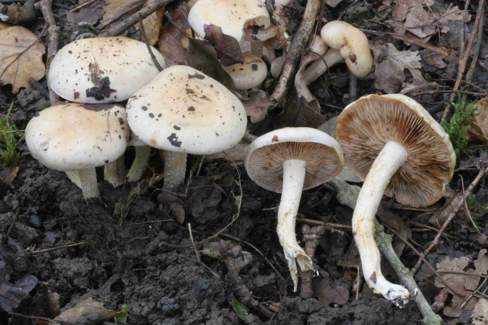 Hebeloma echinosporum (Photo: H. J. Beker)
Hebeloma echinosporum (Photo: H. J. Beker)Taxonomy
Full name: Hebeloma echinosporum Beker & U. Eberh., Fungal Biol. 120: 92 (2015) ["2016"]Genus: Hebeloma
Section: Denudata
Subsection: Echinospora
Types: FRANCE: Pas de Calais, Foret Domaniale de Boulogne Parcel 98 (50.6831°N, 1.7206°E, alt. approx. 50 m a.s.l.) on calcareous soil and litter in deciduous woodland pathside under Carpinus sp., Corylus sp. and Quercus sp., 10 Sep. 2010, H.J. Beker (Holotype. herbarium acc. no. BR BR-MYCO 174907-16 (holotype), C C-F-92313 (isotype), HJB13524).
- arrow_drop_downarrow_drop_upEtymologyWith spores like a sea urchin, from the Latin echinus–, sea urchin, and –sporus, spored to emphasise the warty, in the context of the genus almost spiny, appearance of the spores of this species.
- arrow_drop_downarrow_drop_upDiagnosisThe spores with strong warty, almost spiny, ornamentation, constantly loosening perispore and very strongly dextrinoid together with the shape of the cheilocystidia firmly place this taxon in H. subsect. Echinospora. The species is distinguished from other members of this subsection by the average size of the apex of the cheilocystidium, greater than 7.5 and the spore length less than 12.5 µm.
References
Description
- arrow_drop_downarrow_drop_upThresholds
Description of Hebeloma echinosporum based on 1 collections
- arrow_drop_downarrow_drop_upMacroscopic descriptionPileus: (27) 40 (52) mm diameter; shape convex; characters spotting; margin characters involute; viscosity tacky when moist; colour variation unicolour; colour at centre cream.
Lamellae: attachment emarginate; maximum depth up to 5 mm; number of complete lamellae up to 75; presence of tears visible with naked eye; white fimbriate edge present.
Cortina presence: no.
Stipe: (44) 60 (87) x (5) 6 (9) {median} x (4) 6 (7) {basal} mm; stipe Q 8.3–10.4; base shape cylindrical or tapering; floccosity floccose or pruinose at apex; rooting no; thick rhizoids at base present;
Context: Texture firm; stipe interior hollow or superior wick; stipe flesh discolouring no; slenderness measure up to 13.9; smell raphanoid; taste Not recorded.
Spore deposit colour: Not recorded.
Exsiccata characters: Not recorded.
- arrow_drop_downarrow_drop_upMicroscopic descriptionSpores: shape amygdaloid or limoniform; colour in microscope brown; guttules no. papilla very strongly; Spore Code: O3 O4; P3; D3 D4.
Basidia: 30–37 x 6–8 μm; ave. Q up to 4.3; spore arrangement Not recorded;
Cheilocystidia: main shape clavate-stipitate, filiform or clavate-lageniform or clavate-ventricose; special features observed often apical thickening, branching, clamped septa, rostrate or septa; cheilocystidia ratios: A/M = up to 2.22; A/B = up to 1.57; B/M = up to 1.42.
Pleurocystidia: none seen.
Ixocutis: epicutis thickness (measured from exsiccata) up to 125 μm; ixocutis hyphae width up to 5 μm; ixocutis hyphae encrustation yes; shape of trama elements beneath subcutis thickly sausage-shaped or thinly sausage-shaped up to 18 μm wide.
Caulocystidia: Similar to cheilocystidia but larger.
- arrow_drop_downarrow_drop_upSpore measurements
- arrow_drop_downarrow_drop_upCheilocystidia measurements
- arrow_drop_downarrow_drop_upHabitat and distributionHebeloma echinosporum's preferred habitat appears to be deciduous woodland pathside with calcareous soil and litter. No collections have been recorded where there was only one possible associate. We have additional records where Carpinus, Corylus and Quercus were recorded as possible associates, but in these cases a number of possible associates were always mentioned. Overall the most commonly recorded families are Betulaceae (100.0%) and Fagaceae (100.0%) No growth habit has been recorded.
According to our current collections, the species is found only in Europe. From collector information, it appears collections have been found in the IUCN habitats We map from the collector's description of the habitat to the International Union for Conservation of Nature (IUCN)'s definition using a standardised set of rules. Please see this page for a full list of IUCN habitats.. Within Europe all our records are from the Southwest (France).
- arrow_drop_downarrow_drop_upMolecular resultsThe ITS and the nuclear coding genes of our collection of H. echinosporum are clearly distinct from all other species, but the mitochondrial loci form mixed clades with H. populinum and sequence divergence is small between the two taxa in these loci. There is a single ITS sequence from Galyat, Pakistan (HG796903, with Salix tetrasperma) published that is likely to belong to a relative of H. echinosporum and H. populinum.
- arrow_drop_downarrow_drop_upCommentaryThe spores with strong, almost spiny, ornamentation, constantly loosening perispore and very strongly dextrinoid together with the shape of the cheilocystidia firmly put this taxon in H. subsect. Echinospora. It is distinguished from other members of this subsection by the average size of the apex of the cheilocystidium, between 7.5 and 9.5 μm, and the spore length at most 12.5 μm. We need further collections of this species before we can comment further on plasticity, habitat or distribution.
Geographic distribution
Phenology
- arrow_drop_downarrow_drop_upAdditional cited collections